
The surf clam is a medium-sized marine clam, or bivalve mollusc, found in the Eastern Atlantic from Iceland and northern Norway to Portugal and Spain. Up to 5 centimetres (2.0 in) long, like many clams, the surf clam is a sediment-burrowing filter feeder.
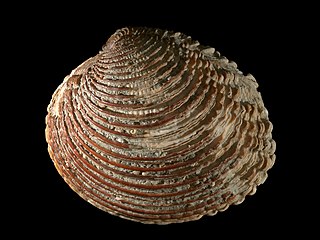
The Veneridae or venerids, common name: Venus clams, are a very large family of minute to large, saltwater clams, marine bivalve molluscs. Over 500 living species of venerid bivalves are known, most of which are edible, and many of which are exploited as food sources.

Mactridae, common name the trough shells or duck clams, is a family of saltwater clams, marine bivalve mollusks in the order Venerida.

The razor shell, Ensis magnus, also called razor clam, razor fish or spoot (colloquially), is a bivalve of the family Pharidae. It is found on sandy beaches in Canada and northern Europe.

Leukoma staminea, commonly known as the Pacific littleneck clam, the littleneck clam, the rock cockle, the hardshell clam, the Tomales Bay cockle, the rock clam or the ribbed carpet shell, is a species of bivalve mollusc in the family Veneridae. This species of mollusc was exploited by early humans in North America; for example, the Chumash peoples of Central California harvested these clams in Morro Bay approximately 1,000 years ago, and the distinctive shells form middens near their settlements.
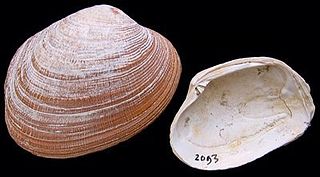
The grooved carpet shell, or Palourde clam, Ruditapes decussatus, or Venerupis decussatus, is a clam in the family Veneridae. It is distributed worldwide and is highly prized due to its ecological and economic interest. It has been proposed as a bioindicator.

Mya truncata, common name the blunt gaper or truncate softshell, is a species of edible saltwater clam, a marine bivalve mollusk in the family Myidae.

Petricolaria pholadiformis, common names false angelwing, or false angel wing (US), and American piddock (UK), is a species of saltwater clam, a marine bivalve mollusk in the family Veneridae, the Venus clams.

The truncate donax, abrupt wedge shell, wedge clam or coquina clam, is a bivalve species in the family Donacidae.

Venus casina is a species of saltwater clam, a marine bivalve mollusc in the family Veneridae, the venus clams. While the species is classified by World Register of Marine Species as Venus casina, the Catalogue of Life uses Circomphalus casina.

Flexopecten glaber is a species of saltwater clam, a scallop, a marine bivalve mollusks in the family Pectinidae, the scallops.

Glossus humanus, the oxheart clam, is a species of species of marine clam found in deepwater off the Atlantic coastline of Europe and Northern Africa. It is the only remaining extant species in the genus Glossus.

Dinocardium is a genus of large saltwater clams or cockles, marine bivalve molluscs in the family Cardiidae, the cockles. There is only one species in the genus, Dinocardium robustum, or the Atlantic giant cockle.
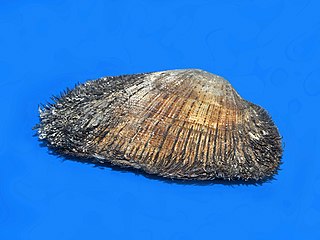
Barbatia barbata is a species of ark clam, a marine bivalve mollusk in the family Arcidae, the ark clams.
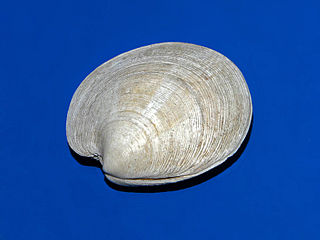
Dosinia exoleta, common name the rayed artemis, is a saltwater clam, a marine bivalve mollusc in the family Veneridae, the venus clams.

Nuttallia obscurata, the purple mahogany clam, dark mahogany clam, varnish clam or savory clam, is a species of saltwater clam, a marine bivalve mollusk in the family Psammobiidae. It was first described to science by Lovell Augustus Reeve, a British conchologist, in 1857.
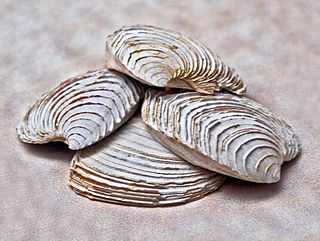
Circomphalus is a genus of saltwater clams, marine bivalve molluscs in the family Veneridae, the venus clams.

Laevicardium crassum, the Norwegian egg cockle, is a species of saltwater clam, a cockle, a marine bivalve mollusc in the family Cardiidae, the cockles.

Solecurtus strigilatus, also known as the rosy razor clam, is a species of saltwater clam, a marine bivalve mollusc in the family Solecurtidae. This mollusc is a suspension feeder and can burrow with great rapidity to escape predators. It is an unusual bivalve in that its shell valves are too small to contain all the soft tissue, and the animal is unable to retreat into its shell.

Spisula subtruncata, the cut through shell, is a medium-sized marine clam, or bivalve mollusc, found in the Eastern Atlantic from Iceland to Morocco and into the Mediterranean Sea. Common and sometimes very numerous. Up to 2.5 centimetres (0.98 in) long, with a distinct triangular shape. This species of clam is found in sandy and silty bottom in the sublittoral zone, where it lives as a sediment-burrowing filter feeder.





















